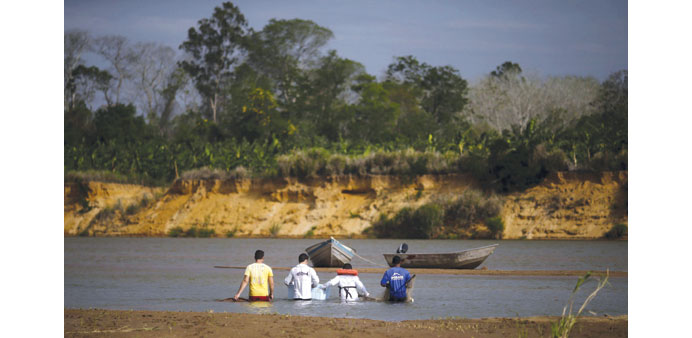Volunteers carry a box of fishes rescued from the waters of the Rio Doce (Doce River) in Linhares, which, according to Brazil’s environmental regulator IBAMA, is about to be flooded with mud after a dam, owned by Vale SA and BHP Billiton Ltd, burst.
AFP
Brasilia
A deadly mine waste spill that buried a village and contaminated a river basin two weeks ago is the worst environmental disaster in Brazilian history, the environment minister said yesterday.
Izabella Teixeira estimated it would take 30 years to clean up the Doce basin in southeast Brazil, where the spill killed at least 12 people, left 280,000 without water and smothered thousands of fish, turtles and other animals.
The disaster struck on November 5, when a dam collapsed at the waste reservoirs of an iron ore mine owned by Samarco, a joint venture between the mining giants BHP Billiton of Australia and Vale of Brazil.
“It’s clear what happened in the Doce River is the biggest environmental catastrophe in this country’s history. We can’t let it happen again anywhere,” Teixeira told newspaper O Globo.
“Our current environmental laws are insufficient to deal with an accident of this magnitude.”
A torrent of yellowish muck burst from the tailings pond, mostly destroying the nearby village of Bento Rodrigues and contaminating the water supply to more than 200 towns.
Twelve people are still missing.
The mud and mining waste have travelled across hundreds of kilometres of river in the states of Minas Gerais and Espirito Santo and is expected to reach the Atlantic Ocean today.
Brazilian President Dilma Rousseff has said the government holds all three mining firms - Samarco, Billiton and Vale - responsible for the disaster.
Samarco has already been hit with damages, fines and frozen funds totalling more than $400mn.
The clean-up could cost more than $1bn, according to Deutsche Bank. Renowned Brazilian documentary photographer Sebastiao Salgado, whose foundation has been active in efforts to protect the Doce River, toured the area and submitted a $27bn clean-up proposal to the government.
“Everything died. Now the river is a sterile canal filled with mud,” he told O Globo.
Meanwhile workers at Vale SA fear for their safety after the Mariana dam burst. The company has been reducing the number of employees because of weak ore prices, despite its push for output and complaints about safety.
For Ronilton Condessa, secretary of the Metabase labour union in Mariana, where Samarco is the main employer, in Minas Gerais state’s iron belt, the dam’s collapse is evidence of the risks the company is taking with its people.
“Now I feel that 100% of the workers at Vale are not safe on the job, and the main reason is that they knew the risk but thought it wouldn’t happen,” Condessa said.
He said nearly 400 mine workers were dismissed in 2015 from Vale’s mining complex of Mariana, even as it squeezed more productivity from the workforce to offset the drop in revenue from iron ore sales to the global steel industry.

